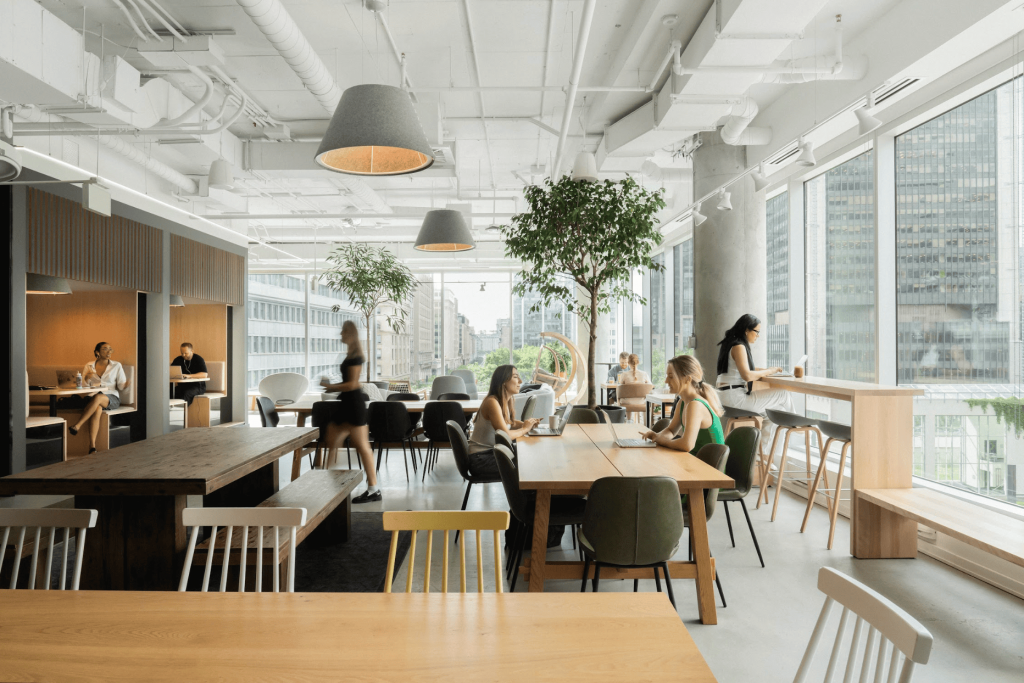The creative agency Cossette has just moved into its new offices located in the heart of Montreal’s business district, two years after relocating to WeWork. Louis Duchesne, its president for Quebec and Eastern Canada, reflects on this experimental phase and the birth of the “structured flexibility” philosophy aimed at fostering collective productivity.
Hello Louis. Cossette had occupied its previous offices for over 20 years before the pandemic. How did this change come about?
Louis Duchesne: Like many, COVID made us question the infrastructure model and the employee experience of the future. Our lease was set to expire in November 2020, a year and a half after the pandemic began. It was still during COVID, but we had gained some perspective and realized we could not return to how things were before.
So, we made the very important decision not to renew our lease and to leave our historic space. Our mindset was to position ourselves for experimentation.
Hence your desire to settle in a WeWork space?
Louis Duchesne: Yes, we wanted to take the time to see which arrangements worked or didn’t for our teams. The advantage with WeWork is that the setup is quick. Everything is already arranged, with an exclusive space for us.
Another positive point: flexibility. No need to sign a 10-year lease. This flexible arrangement allowed us to conduct our learning while staying alert to market opportunities and keeping our options open for choosing our future permanent location.
For two years, we were able to test different options (mandatory in-person attendance at certain times, coming to the office when teams wanted, etc.). This allowed us to identify which personalities or roles preferred being in the office rather than working remotely. These learnings helped us make informed decisions for our new offices.

With these insights, what arrangement did you ultimately choose?
Louis Duchesne: First, I want to emphasize that we do not claim our choice can apply to all companies. It is primarily the result of our experiments and the type of culture and experience we want to offer. When we researched the evolution of the work environment, we quickly realized that there wasn’t a one-size-fits-all solution.
In other words, our key learning is that it’s less about a ready-made recipe and more about a company philosophy. For instance, we have a strong conviction: we believe in in-person work.
What does that mean?
Louis Duchesne: We’ve heard many people say they are very productive at home. I acknowledge and understand that. But through our learnings, we discovered a real nuance between individual productivity and collective productivity.
We work in an industry where collective productivity is critical, whether it’s to generate ideas, build relationships with clients, or find solutions for them. Therefore, we need to ensure we create good collective productivity. This reflection is the foundation of our company philosophy and is reflected in the in-person experience we wanted to offer our talents.

How so?
Louis Duchesne: On one hand, we require a minimum presence of three days per week in the office. Teams organize among themselves regarding the chosen days, although I must acknowledge that for most, it’s Tuesday to Thursday.
We tried experimenting with a completely flexible model at WeWork, where everyone came when they wanted. We quickly realized that it worked only moderately. The experience was not very engaging, with a clear lack of synchronicity. What’s the point of coming to the office if you’re the only one from your team present?
We settled on a model we could call “structured flexibility.” We offer flexibility within a defined framework.
What has been the reaction from the teams?
Louis Duchesne: Everyone understood these conclusions, and no one left the company because of it. Better yet, between fall 2023 and spring 2024, we improved our engagement score by 6 percentage points, knowing that it was already above 80%, which is quite high for our industry. So we can clearly say that this has contributed to our talents’ engagement.
Also, we measured that the average occupancy rate of the space was around 70%, including Mondays and Fridays. This aligns well with what we had envisioned in our plans.

What has been the evolution of team size and office space from the beginning of the pandemic to today?
Louis Duchesne: Team size is similar, around 500 people. Regarding office space, we’ve reduced from 85,000 square feet to 35,000 square feet. This drastic reduction is due to a greater optimization of spaces, given that we are rarely at 100% occupancy in the office, considering vacations, appointments, or remote work.
Do you utilize flexible workstations, or does each employee have an assigned desk?
Louis Duchesne: We offer both. It depends on individual preferences.
Was the choice of downtown also a criterion for you?
Louis Duchesne: Yes. We were already downtown before. For us, it’s part of the employee experience quality we want to offer. Access to cultural products, restaurants, shops, as well as various modes of transportation (REM, Bixi, bus lines, suburban networks, etc.).
Moreover, we believe in the vitality of downtown areas and, on our modest scale, we want to contribute to that by bringing our teams there.

And in terms of layout, what choices did you make?
Louis Duchesne: We took a lot of inspiration from WeWork. For example, we created a very bright bistro, a hub that serves as a workspace, meeting area, and informal gathering place over coffee.
We also maintained an open layout but ensured there are enough individual spaces for a bit of privacy. Finally, we made sure that technology was well-integrated.

One last question. The return to the office has not been without its challenges for some companies. What is your experience with this?
Louis Duchesne: I would say it’s important to be clear and stand by your company philosophy. In our case, through our experiments, we realized that emphasizing collective productivity was part of the experience we wanted to offer our talents. This clarity has been beneficial for us and our teams.
The choice of three days is also explained by this. The “default” is significant. Being in-person three days a week means that, by default, you organize your week around your office presence. Not the other way around, where being at home is the default. It may seem trivial, but it makes a big difference.




